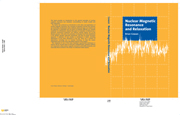Book contents
- Frontmatter
- Contents
- Preface
- 1 Introduction
- 2 Theoretical background
- 3 Detection methods
- 4 Classical view of relaxation
- 5 Quantum treatment of relaxation
- 6 Dipolar lineshape in solids
- 7 Relaxation in liquids
- 8 Some case studies
- 9 The density operator and applications
- 10 NMR imaging
- Appendix A Fourier analysis
- Appendix B Random functions
- Appendix C Interaction picture
- Appendix D Magnetic fields and canonical momentum
- Appendix E Alternative classical treatment of relaxation
- Appendix F Gm(t) for rotationally invariant systems
- Appendix G P(Ω, Ωo, t) for rotational diffusion
- Problems
- References
- Index
8 - Some case studies
Published online by Cambridge University Press: 02 December 2009
- Frontmatter
- Contents
- Preface
- 1 Introduction
- 2 Theoretical background
- 3 Detection methods
- 4 Classical view of relaxation
- 5 Quantum treatment of relaxation
- 6 Dipolar lineshape in solids
- 7 Relaxation in liquids
- 8 Some case studies
- 9 The density operator and applications
- 10 NMR imaging
- Appendix A Fourier analysis
- Appendix B Random functions
- Appendix C Interaction picture
- Appendix D Magnetic fields and canonical momentum
- Appendix E Alternative classical treatment of relaxation
- Appendix F Gm(t) for rotationally invariant systems
- Appendix G P(Ω, Ωo, t) for rotational diffusion
- Problems
- References
- Index
Summary
Calcium fluoride lineshape
Why calcium fluoride?
Although the calculation of the NMR absorption lineshape in a solid is a well-defined problem, the discussions of Chapter 6 have indicated that a complete and general solution is difficult and indeed unlikely. From the practical point of view one would like to explain/understand the characteristic features of transverse decays and lineshape as reflecting details of internal structure and interactions, while from the theoretical point of view the interest is the possibility of treating a ‘relatively’ simple many-body dissipative system.
In this respect it is worthwhile to consider the solvable models considered in Chapter 6. The model of Section 6.2 actually arose from discussions in the seminal paper on calcium fluoride by Lowe and Norberg in 1957. The essential point was that the time evolution generated by the dipole interaction is complicated because of non-commutation of the various spin operators. In the solvable models there is only an IzIz part of the interspin interaction. Since the Zeeman interaction also involves only Iz this means that all operators commute and the time evolution can be calculated purely classically. It is only in this case that the evolution of each spin can be factored giving a separate and independent contribution from every other spin. In other words it is only in this case that each spin can be regarded as precessing in its own static local field – and the problem is solved trivially. Each many-body eigenstate is simply a product of single-particle eigenstates. However, once transverse components of the interspin interaction are admitted then everything becomes coupled together and a simple solution is no longer possible. The many-body eigenstates no longer factorise.
- Type
- Chapter
- Information
- Nuclear Magnetic Resonance and Relaxation , pp. 254 - 290Publisher: Cambridge University PressPrint publication year: 1997



